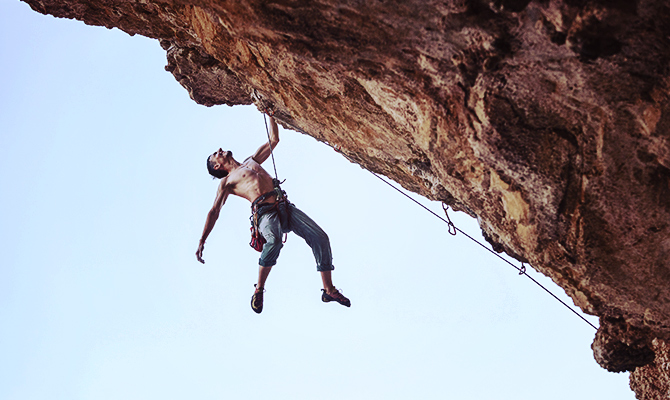HIKING & WALKING GUIDE FOR GREAT Essential Hiking
Rock climbing is a sport in which participants climb up, down or across natural rock formations or artificial rock walls. The goal is to reach the summit of a formation or the endpoint of a usually pre-defined route without falling. Rock climbing is a physically and mentally demanding sport, one that often tests a climber's strength, endurance, agility and balance along with mental control. Knowledge of proper climbing techniques and the use of specialized climbing equipment is crucial for the safe completion of routes Because of the wide range and variety of rock formations around the world, rock climbing has been separated into several different styles and sub-disciplines such as scrambling, another activity involving the scaling of hills and similar formations, differentiated by rock climbing's sustained use of hands to support the climber's weight as well as to provide balance Professional rock climbing competitions have the objectives of either completing the route in the quickest possible time or attaining the farthest point on an increasingly difficult route. Indoor Rockclimbing is typically split into three disciplines. These disciplines are bouldering, lead Climbing, and top Roping.
Paintings dating from 200 BC show Chinese men rock climbing. In early America, the cliff-dwelling Anasazi in the 12th century are thought to have been excellent climbers. Early European climbers used rock climbing techniques as a skill required to reach the summit in their mountaineering exploits. In the 1880s, European rock climbing became an independent pursuit outside of mountain climbing.

Boxing and Health
Although rock climbing was an important component of Victorian mountaineering in the Alps, it is generally thought that the sport of rock climbing began in the last quarter of the nineteenth century in various parts of Europe. Rock climbing evolved gradually from an alpine necessity to a distinct athletic activity. From the middle of the 19th century, the founder of the Alpine Club, John Ball, researched and made known the Dolomites.
Boxing news, articles and information
Just before the First World War, there was a so-called "Mauerhakenstreit" German: the Great Piton Debate of 191in Central Europe regarding the use of aids in climbing and mountaineering. Paul Preuss and Hans Dülfer were the main actors in these discussions, which have essentially continued to this day. Preuss propagated a pure climbing style. Angelo Dibona, on the other hand, was an advocate of security.
5 Things You Didn’t Know About Climbing
- When Your Hike Doesn't Go As Planned
- Hot Weather: How Can It Kill
- Cold Weather: How Can It Kill
- Most Essential Hiking Equipment
- What is Orienteering
by Hetmayar Most of the climbing done in modern times is considered free climbing—climbing using one's own physical strength, with equipment.
Most of the climbing done in modern times is considered free climbing—climbing using one's own physical strength, with equipment used solely as protection and not as support—as opposed to aid climbing, the gear-dependent form of climbing that was dominant in the sport's earlier days. Free climbing is typically divided into several styles that differ from one another depending on the choice of equipment used and the configurations of their belay, rope and anchor systems.

As routes get higher off the ground, the increased risk of life-threatening injuries necessitates additional safety measures. A variety of specialized climbing techniques and climbing equipment exists to provide that safety. Climbers will usually work in pairs and utilize a system of ropes and anchors designed to catch falls. Ropes and anchors can be configured in different ways to suit many styles of climbing, and roped climbing are thus divided into further sub-types that vary based on how their belay systems are set up.
The most commonly used method to ascend climbs refers to climbs where the climber's own physical strength and skill are relied upon to accomplish the climb. Free climbing may rely on top rope belay systems, or on lead climbing to establish protection and the belay stations. Anchors, ropes and protection are used to back up the climber and are passive as opposed to active ascending aids. Sub-types of free climbing are trad climbing and sport climbing.















03 Comments
Rosalina Kelian
19th May 2025Lead climbing is a climbing technique. The lead climber ascends with the rope passing through intermittent anchors that are below them, rather than through a top anchor, as in top-rope climb. A partner belays from below the lead climber, by feeding out enough rope to allow upward progression without undue slack.
Rosalina Kelian
19th May 2025Unlike top-rope climbing, where the climber is always supported by an anchor located above the climber, lead climbing often involves scenarios where the climber will be attached to a point under him or her.
Rosalina Kelian
19th May 2025The climbing rope is of a fixed length; the climber can only climb the length of the rope. Routes longer than the rope length are broken up into several segments called pitches; this is known as multi-pitch climbing.
03 Comments